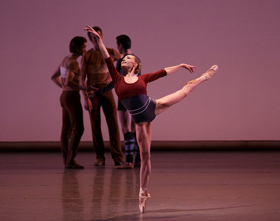Review: New York City Ballet presents Ratmansky, Moretti and Peck, April 26, 2019.

New York City Ballet opened its spring season with a week of 21st-century ballets-no Balanchine, or Robbins, just anything that was created after 2000. Some prove eminently worthwhile and destined to remain in the company's repertoire for a long time; others, I'm not quite sure.
It's still too early to discuss the company's new management style; I'll wait until September to make any pronouncements. I know people are already disappointed or bearing grudges. I'm not one of them.
Friday, April 26, 2019, presented a fascinating mix of choreographers: Ratmansky, Moretti, and Peck-all accomplished, all with a quite interesting visual style and approach to dance. If this is what the 21st century has to offer-at least as of now-it's going to be of immense importance. And that doesn't include other choreographers who were not presented or have not been born yet.
Ratmansky's Pictures at an Exhibition, to the piano score of Modest Mussorgsky's grand music canvas of Russian paintings, was well played by Susan Walters, with arresting costumes designed by Adeline Andre, and projected visuals of Wassily Kandinsky juxtaposing various shapes.
It all sounds very precious, but in fact, it is a very grand breathtaking ballet. Ratmansky has not taken his cue from the titles assigned each section: The Old Castle, the Gnome, Samuel Goldenberg and Schmuyle. Instead, he lets his choreography build upon the music, layering it with ideas that are architecturally conceived, allowing for solemnity, playfulness or grandiosity. Like so many of Balanchine's works, it takes its cue from the music. Make of it what you will, but be assured that you notice that every detail has been placed by Mr. Ratmansky so smoothly and confidentially, yet giving his dancers the freedom to assert their individuality, that the creative force only deepens with each successive viewing,
Besides the choreography, which received the deserved applause, the cast: Sterling Hyltin, Lauren King, Georgina Pazcoguin, Gretchen Smith, Indiana Woodward, Tyler, Angle, Joseph Gordon, Aaron Sanz, Taylor Stanley, and Daniel Ulbrich were all wonderful.
Mauro Bigonzetti's Oltremare, meaning "beyond the sea," could be a beautiful theatrical piece if it just had more dash, more panache. Its problem is that it's all synthetic. From the moment the curtain rises on suitcases being pushed by dancers who then sit down on them, only to get up and keep pushing more, strikes a false note. It tells us what all we know about the ballet. It's all about dislocation; immigrants who want to be admitted somewhere to live and enjoy freedom. It is very dark, very piercing, but we've all seen this before
The music by Bruno Moretti, a long-time collaborator of Mr.Bigonzetti 's , is composed for 21 musicians and features a fisarmonica (the Italian version of the accordion.) It is somber, painful, yet there are moments of liveliness. The two main couples, Maria Kowroski, and Tyler Angle; Brittany Pollack and Peter Walker all contributed compelling characterizations, even if they did evoke unspoken soap opera. While it may have just avoided banality, its descent into a sort of lackluster dance naturalism made it resistible to me.
Justin Peck's Rodeo: Four Dance Episodes, offers a great deal of fun and some contemplation. Set to the iconic Aaron Copland music, which brings up memories of Agnes de Mille's choreography, it sets the original dance about a farm girl learning to cope with impending adulthood on its ear. Here there are squadrons of men rushing to and fro. They jostle, they play, they dance with each other-no one seems to care. It's all in the name of male camaraderie. But wait. There is a pas de deux, beautifully and tenderly danced between Sara Mearns and Russell Janzen, that puts all the boys in the frat house away in the corner for a bit. Here there is relaxation, time for the pair to grow with each other. And we get to see Russell Janzen be more than just a reliable and dependable partner. He can be loving, attentive to the abundantly talented Sara Mearns. They can enjoy each other's company. And we enjoy it with them until the final rush of music brings everything to a swelling theatrical finale.
The orchestra, led by Andrew Litton, seemed unfocused and out of tune many times. I hope this can be corrected.
As for the lighting of the ballets.
You've heard everything already. New York City Ballet lives up to its reputation. Need I say more?
Sara Mearns in Justin Peck's Rodeo: Four Dance Episodes.
© Paul Kolnik.
Reader Reviews
Videos

